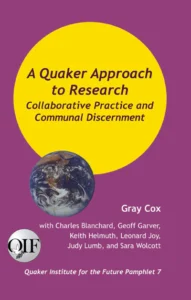 Summary: An exploration of Quaker practices of group discernment in an academic or research setting.
Summary: An exploration of Quaker practices of group discernment in an academic or research setting.
I picked A Quaker Approach to Research because the two main streams of Christian Discernment are the Ignatian or Quaker streams. I have a decent background in Ignatian discernment but only a little background in Quaker discernment. This book was free in the Kindle Unlimited library, so I was willing to try it even though it was not exactly what I was looking for.
There was a good introduction to the history of Quaker discernment. One of the new pieces of information I found was that early Quakers called themselves the “Religious Society of Friends of the Truth” before being known as The Society of Friends or Quakers. Discernment of the direction of the Holy Spirit or the “inward light” of God within them was central to the movement. Like the Ignatian stream of discernment, reason and emotion are part of the discernment process. Ignatian discernment is often done in partnership with a spiritual director, but Quaker discernment is usually done in a group, maybe with a facilitator, but a significant focus is on group silence or communal meditation. This communal meditation is part of the method of “moving evenly together.”
One of the more helpful parts of this book is quoting Leonard Joy about the essentials of Quaker practice. This was done in intentionally secular terms to help translate the concepts to an academic setting.
“The practices includes:
- grounding of all participants in the desire for the common good
- preparing factual and analytical material prior to the meeting
- ensuring that all voices are heard and listened to
- respect for all affected by the decision-making process
- sensitivity to interdependence—open systems thinking
- speaking out of the silence
- addressing the clerk not one another
- speaking simply and not repeating what has already been offered
- speaking one’s own truth without advocating that all should act on it
- a commitment to express reservations
- being authentic with the expression of feeling without using emotion to sway others
- distinguishing “threshing” meetings from meetings for decision making
- clerk offering syntheses of the “sense of the meeting” that are modified until there is unity
- making decisions not by majority vote, nor by consensus, but by unity.” (Kindle location 686)
Much of the book was not what I was looking for because it was designed as a committee report on how Quaker discernment processes could be used in a non-religious academic setting. I am most interested in discernment within a Christian setting. I skimmed parts and skipped a few parts that were just not what I was interested in. But there was enough that was useful that I am glad I picked it up.
Some of the formatting of the ebook was pretty bad. Nothing that made it unreadable; I have seen worse. But there were lots of extra characters and that was distracting.
A Quaker Approach to Research: Collaborative Practice and Communal Discernment – Purchase Links: Kindle Edition
1 thought on “A Quaker Approach to Research: Collaborative Practice and Communal Discernment”